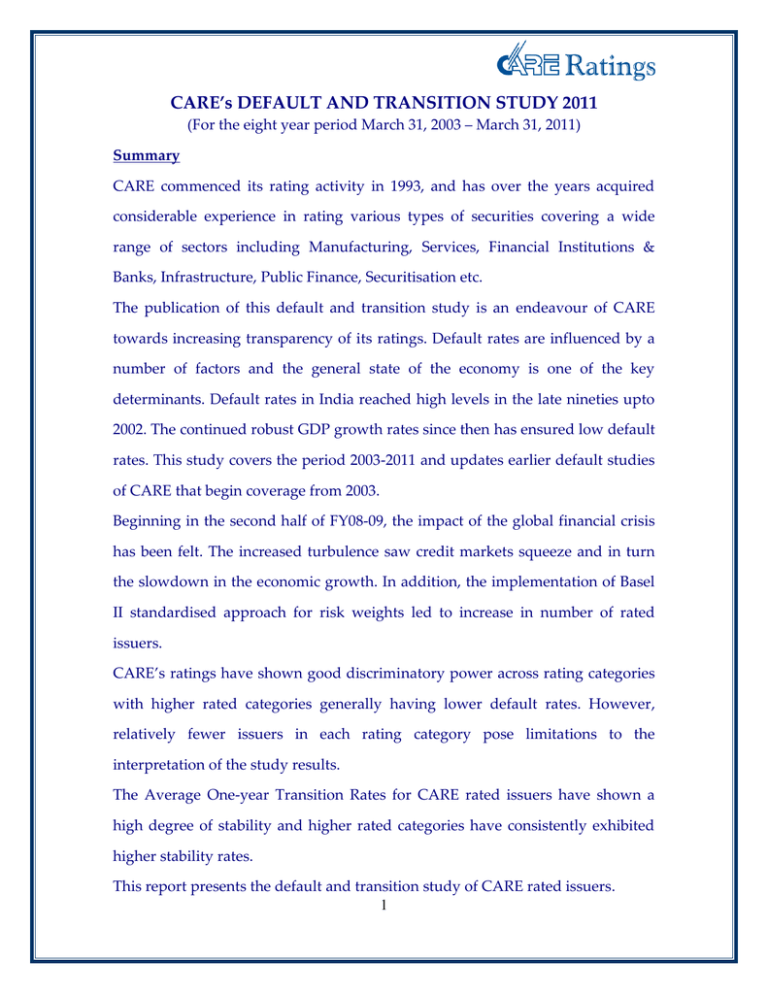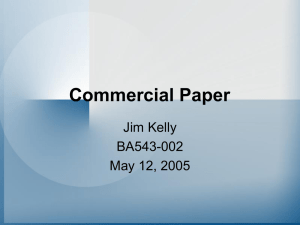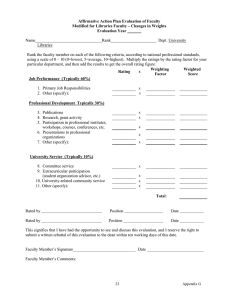CARE’s DEFAULT AND TRANSITION STUDY 2011
advertisement

CARE’s DEFAULT AND TRANSITION STUDY 2011 (For the eight year period March 31, 2003 – March 31, 2011) Summary CARE commenced its rating activity in 1993, and has over the years acquired considerable experience in rating various types of securities covering a wide range of sectors including Manufacturing, Services, Financial Institutions & Banks, Infrastructure, Public Finance, Securitisation etc. The publication of this default and transition study is an endeavour of CARE towards increasing transparency of its ratings. Default rates are influenced by a number of factors and the general state of the economy is one of the key determinants. Default rates in India reached high levels in the late nineties upto 2002. The continued robust GDP growth rates since then has ensured low default rates. This study covers the period 2003-2011 and updates earlier default studies of CARE that begin coverage from 2003. Beginning in the second half of FY08-09, the impact of the global financial crisis has been felt. The increased turbulence saw credit markets squeeze and in turn the slowdown in the economic growth. In addition, the implementation of Basel II standardised approach for risk weights led to increase in number of rated issuers. CARE’s ratings have shown good discriminatory power across rating categories with higher rated categories generally having lower default rates. However, relatively fewer issuers in each rating category pose limitations to the interpretation of the study results. The Average One-year Transition Rates for CARE rated issuers have shown a high degree of stability and higher rated categories have consistently exhibited higher stability rates. This report presents the default and transition study of CARE rated issuers. 1 CARE’s Default Study This section examines default experience of CARE’s long-term and medium-term ratings from March 31, 2003 to March 31, 2011. CARE has used Cohorts method to calculate the performance of CARE rated entities across various rating categories. Category-wise Cumulative Default Rate (CDR) is calculated for each cohort within the period of study. The CDR is calculated over one, two and three year time horizons to evaluate the performance of ratings over varying periods. Then the issuer weighted average for one-year, two-year and three-year CDR is computed to arrive at the long term CDR for each category. As ratings are a measure of Probability of Default, a higher rating given to an entity implies lower credit risk and should therefore have lower CDR and CARE’s CDR numbers generally display this property. CARE’s definition of default for this CDR study and detailed methodology for computing CDR is presented in Annexure I. The CDR study includes ratings of issuers across all sectors – banks, financial institutions and corporates. Ratings of Structured Obligations (SO) are not a part of this study which would comprise securitisation transactions, ratings backed by third-party guarantees or instruments with a structured payment mechanism. Static Pool / Cohort The study tracks the long/medium-term ratings assigned and accepted by the issuer and is based on issuer-specific data and not instrument-specific data (thus counting an issuer only once). The rating of senior-most long-term debt of an issuer is considered as the rating of that issuer. If CARE has not rated the long-term instrument of that issuer, then the medium-term rating is considered as the issuer’s rating. 2 Static pools / Cohorts for the study are the number of issuers outstanding in each rating category as on the beginning of each cohort falling within the study period. Default experience of each rating category for each cohort is examined over one, two and three-year periods. Rating category-wise number of issuers is presented below in Table 1: Table 1: Issuers Outstanding at the beginning of each Cohort period Rating Category Number of Issuers at the beginning of the cohort period as on 31st MarMarMarMarMarMarMarMar03 04 05 06 07 08 09 10 AAA 11 15 15 21 23 31 44 47 AA 23 31 39 48 49 63 92 115 A 17 19 16 25 31 65 167 221 BBB 12 12 13 15 11 33 273 560 2 4 4 4 2 1 69 210 65 81 87 113 116 193 645 1153 Below Investment Grade Total Key Observations on Cohort Size & Composition Structural shift in rating universe o The period beginning from March 2008 witnessed a structural shift in the rating universe as the Basel II standardized approach for credit risk was implemented for banks by the RBI. Two key changes that can be observed are the multiple times increase in the overall number of issuers and the increase in issuer rated below AA category. o In India, the banking sector is still the primary source of debt funding and prior to Basel II implementation, bank borrowings of companies were unrated. Post Basel II implementation, many of the corporates with bank borrowings are getting rated leading to the manifold increase in number of issuers. o The corporate bond market in India is skewed towards higher rated entities. Therefore, the rating universe primarily comprised of higher rated borrowers before Basel II implementation. Statistical Limitations o While we have observed an increase in the number of issuers in the recent cohorts of March 2009 and March 2010, our study 3 encompasses the entire period from 2003-20011 wherein majority of the cohorts had small size limitation. For example before March 2007, none of the rating category below AA had sample size of more than 30. Further, till March 2008, the number of issuers with ratings below investment grade were very few (ranging from 1 to 4). o With small sample size it would be difficult to draw meaningful conclusions from such a study. Nevertheless the study is important for drawing broad inferences. o However with the size of cohorts growing substantially in recent period, more meaningful conclusions can be drawn in future. CARE’s Cumulative Default Rate CARE’s one-year, two-year and three-year cumulative issuer weighted average default rates consistently follow the principle of ordinality and are lower in the higher rating categories and increase as we move down the rating categories (presented in Table 2 below) Table 2: CARE’s Issuer Weighted Cumulative Default Rates for the period March 2003 - March 2011 One Year Two Year Avg. No. of Issuers CDR(%) AAA 25.9 0.00 AA 57.5 A Rating Category BBB Below Investment Grade Total Avg. No. of Issuers Three Year CDR(%) Avg. No. of Issuers CDR(%) 22.9 0.00 19.3 0.00 0.22 49.3 0.58 42.2 1.19 70.1 0.53 48.6 2.06 28.8 4.05 116.1 2.69 52.7 6.23 16.0 5.21 37.0 8.78 12.3 15.12 2.8 17.65 306.6 2.24 185.7 3.46 109.2 2.75 The categories of AA, A, BBB, BB, B and C include ratings with the suffix ‘+’ or ‘–‘ within the respective categories. Thus, for instance, the AA category includes three ratings: AA+, AA and AA-. Key Observations There were no instances of default (in any Cohort) in AAA rating category during the period of this study. 4 Small sample size limitation continues to affect the study. For the threeyear CDR computation, average sample size is less than 30 for all categories (except AA) and is only 2.8 for below investment grade ratings. The two cohorts of March 2009 and March 2010 with maximum sample size could not even be considered for the three-year computation as they had not completed 3 year performance. For the one-year and the two-year CDRs sample size has improved due to inclusion of recent cohorts. As the sample size continues to increase more meaningful conclusions can be reached. Despite these limitations, it can be observed that CARE’s CDRs display good discriminatory power with higher rating categories having lower CDRs. CARE’s structured obligation ratings include Asset Backed Securitization (ABS), Mortgage Backed Securitization (MBS), Obligations of state level entity backed by state/central government guarantee and instruments backed by credit enhancing guarantees / letter of comfort etc. While structured obligation ratings are not part of this study, the ABS and MBS ratings which form majority of CARE’s structured obligation ratings have not witnessed any default till date. In case of state / central government guarantee backed ratings, some delays of short term nature were observed which were due to operational issues of non-invocation of guarantees or due to delay in compliance with internal government procedure towards making the funds available to the rated entity. 5 Transition Study Rating transition study looks at how ratings have changed over a period of time, an important aspect analyzed by CARE to evaluate the stability/migration of its ratings. Methodology for transition rates Methodology used by CARE for studying rating transition is discussed below: The static pools, also known as cohorts, are created by grouping issuer ratings according to the year in which the ratings are active and outstanding at the beginning of the year. The study tracks the long/medium-term ratings assigned and accepted by the issuer on a year-to-year basis. The study is based on issuer-specific data and is not instrument-specific. Thus, it counts an issuer only once and avoids distortion. The transition study includes ratings of issuers across all sectors – banks, financial institutions and corporates. Structured Obligations (SO) are not a part of this study. Individual cohorts have been formed for each year under study; in all 8 cohorts have been prepared for the period of study. Each individual cohort for a given financial year consists of the ratings outstanding in various rating categories at the beginning of the financial year and tracks the changes in rating, if any, during the one-year period therefrom. For example, the 2003 cohort represents the ratings outstanding as on March 31, 2003 and their transitions or changes (upgrades, downgrades and re-affirmation) in the subsequent year till March 31, 2004. Data from all individual cohorts have been pooled together to obtain the weighted average transition matrix. 6 Since the rating of an issuer both at the beginning and the end of a study period is required for the computation of transition rate, any issuer whose rating has been withdrawn / suspended has been removed from the relevant opening cohort. The table shows issuer weighted average transition rates on the CARE rating scale over the period 2003-2011. Table 3: Average 1-year Rating Transition Rates for the period FY 2003-2011 (%) Rating Category IssuerYears AAA AA A BBB Below Investment Grade AAA 198 98.99 1.01 0.00 0.00 0.00 AA 445 1.57 95.96 2.02 0.22 0.22 A 530 0.00 4.15 86.23 8.30 1.32 BBB 873 0.00 0.23 4.01 88.89 6.87 Below Investment Grade 255 0.00 0.00 0.00 11.76 88.24 * Below Investment Grade refers to ratings below BBB- (i.e. BB+ till D) The categories of AA, A, BBB, BB, B and C include ratings with the suffix ‘+’ or ‘–‘ within the respective categories. Thus, for instance, the AA category includes three ratings: AA+, AA and AA-. The diagonals of the above table represent the stability of a particular rating category in one year for the period FY 2003 - 2011. Based on CARE’s average one-year transition matrix, it can be inferred that out of all the AA rated companies at the beginning of the year, 95.96% have remained at the same category AA at the year ending. Out of the remaining AA rated companies, 1.57% have been upgraded to AAA and 2.47% have been downgraded. Similar interpretation can be done for other rating categories as well. 7 Stability of Ratings Stability rate for each rating category indicates percentage of ratings remaining in the same category at the end of one year. One-year average stability of CARE’s ratings during the period 2003-2011 is presented below: It can be observed from the above chart that CARE’s higher rating categories AAA and AA exhibit high level of stability within one-year period. Stability rates of CARE’s higher rating categories have generally been higher than those for the lower rating categories. Disclaimer CARE has taken due care and caution in compilation of the data for this publication. Information has been taken by CARE from sources it considers accurate and reliable. CARE does not guarantee accuracy, adequacy or completeness of any information and is not responsible for any errors or omissions for the results from the use of such information. CARE especially states that it has no financial liability whatsoever to any use on account of the use of information provided in this publication. This material is not intended as an offer or solicitation for purchase or sale of any financial instruments. CARE’s ratings are opinions on credit quality and are not recommendations to buy, sell or hold any security. CARE has based its ratings on information obtained from sources believed by it to be accurate and reliable. CARE does not, however, guarantee the accuracy, adequacy or completeness of any information and is not responsible for any errors or omissions or for the results obtained from the use of such information. Most issuers of securities rated by CARE have paid a credit rating fee, based on the amount and type of securities issued. 8 Annexure I Definition of Default for the Study For the purpose of this study, default has been defined as any missed payment on the rated instrument i.e. a single rupee delay even for a single day has been treated as default. Concept of Static Pool / Cohort Static Pool / Cohort for the study is the number of issuers outstanding in each rating category as on a given date. Default experience of each rating category is examined over the study period. New issuers during the study period are not considered and in that sense the data pool remains static. If the rating of the company included in the cohort gets withdrawn, it is treated as withdrawal for the rest of the period of the cohort. If the company whose rating is included in the cohort defaults, it is treated as default for the rest of the period of the cohort. However those entities, which are rated again after withdrawal or which recover from default (and are rated again), are taken as new entities for relevant subsequent cohorts. Structured obligation (SO) ratings are not part of this study. CARE’s structured obligation ratings include Asset Backed Securitization (ABS), Mortgage Backed Securitization (MBS), Obligations of state level entity backed by state/central government guarantee and instruments backed by credit enhancing guarantees / letter of comfort etc. 9 Cumulative Default Rate (CDR) Cumulative Default Rate (CDR) shows the number of defaults from a given static pool as a proportion of total issuers in that static pool and provides an estimate of default frequency. For a given static pool, three-year CDR is computed as follows: Three-Year CDR = No. of issuers which defaulted over the three-year period / No. of issuers outstanding at the beginning of the three-year period. A hypothetical example is presented here: AAA AA A BBB Opening Issuers (A) Cohort 1 Defaults during next 3 years (B) 50 40 30 20 0 1 2 3 3 Yr CDR = (B/A) (%) 0.00 2.50 6.67 15.00 Opening Issuers (A) Cohort 2 Defaults during next 3 years (B) 60 50 20 15 0 1 2 3 3-Yr CDR = (B/A) (%) 0.00 2.00 10.00 20.00 Issuer weighted average three-year CDR is computed to arrive at the average CDR over a specified period of time. The above example is continued here to arrive at the average CDR: AAA AA A BBB 3 Yr CDR (C1) (%) 0.00 2.50 6.67 15.00 Cohort 1 Opening Issuers (W1) 50 40 30 20 3 Yr CDR (C2) (%) 0.00 2.00 10.00 20.00 Cohort 2 Opening Issuers (W2) 60 50 20 15 10 Weighted Average 3 Yr CDR =(C1*W1+C2*W2)/(W1+W2) (%) 0.00 2.22 8.00 17.14 Analyst Contacts Head Office Rajesh Mokashi Deputy Managing Director Tel- +91-22-67543636 rajesh.mokashi@careratings.com Credit Analysis & Research Ltd. 4th Floor, Godrej Coliseum, Somaiya Hospital Road, Sion (East), Mumbai – 400 022. INDIA Tel: 022 – 6754 3456 Regional Office Vijay Agrawal Joint General Manager Tel- +91-22-67543416 vijay.agrawal@careratings.com Abhinav Sharma Assistant General Manager Tel- +91-22-67543508 abhinav.sharma@careratings.com Unit No. O-509/C, Spencer Plaza, 5th Floor, No. 769, Anna Salai, Chennai 600 002 Tel: 044 2849 7812/2849 0811 3rd floor, B-47, Inner Circle Near Plaza Cinema, Connaught Place New Delhi - 110 001. Tel – 011 2331 8701/2371 6199 3rd Floor, Prasad Chambers (Shagun Mall Building) 10A, Shakespeare Sarani Kolkata - 700 071. Tel – 033 2283 1800/1803 32 TITANIUM Prahaladnagar Corporate Road, Satellite, Ahmedabad - 380 015. Tel – 079 4026 5656 401, Ashoka Scintilla 3-6-520, Himayat Nagar Hyderabad - 500 029 Tel – 040 40102030 Unit No. 8, I floor, Commander's Place No. 6, Raja Ram Mohan Roy Road, Richmond Circle, Bangalore - 560 025. Tel – 080 2211 7140 11






